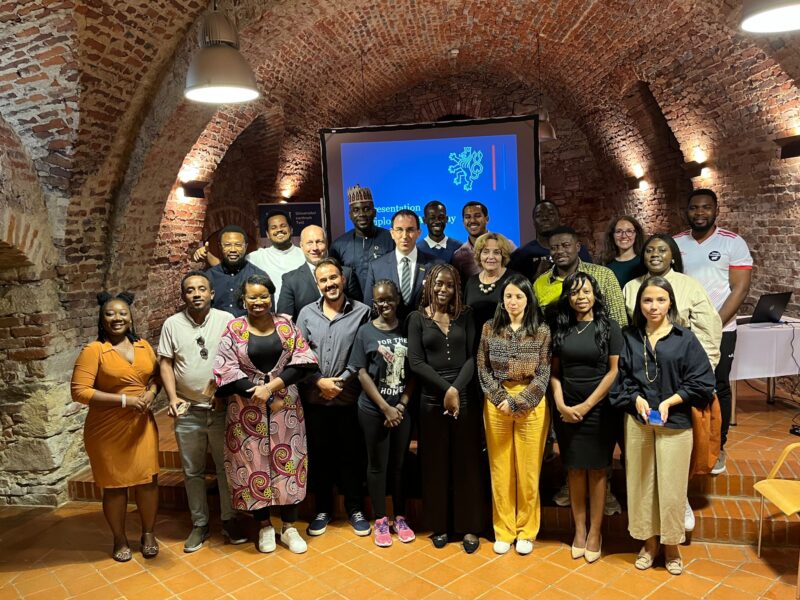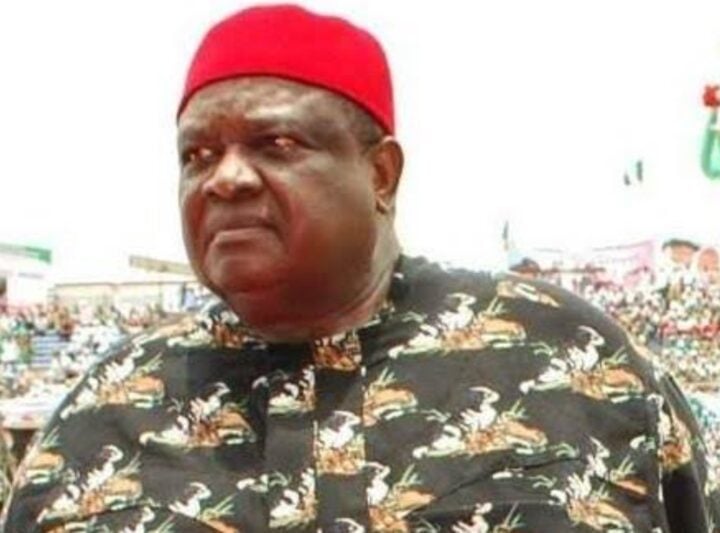In villages without bank branches, service agents visit households to collect deposits and issue receipts from a fingerprint-authentication device. An agent collects a deposit from a woman in a village in the western Indian state of Maharashtra | Photo Nikkei Asia
BY OLU AKANMU
India has 80% formal financial inclusion, measured by the percentage of Indians with formal financial accounts despite the vastness of its territory and a population of 1.4 billion people. The comparable statistics in Nigeria is 51% measured by those with formal financial accounts from the most recent EFINA study in 2020. The percentage of the population with formal financial accounts is actually the more critical metric in financial inclusion programmes, with regards to making a real fundamental dent in financial exclusion and ensuring a larger social impact.
It is those who have formal financial accounts that can borrow and access formal microcredit at scale because their payments and transaction behaviour are known, which can be used to profile them for credit services, to lift their trade and themselves out of poverty. India has six and half times the population of Nigeria and three and half times the geographical size of Nigeria. If India could achieve 80% of its population with a formal financial account despite its vast geographic size, huge population, similar demographic structure with Nigeria and Africa with regards to social inequalities and large informality, there should be very good lessons Nigeria and Africa could learn from India.
There is also a fierce urgency of how to tackle, even more head-on, the challenge of financial inclusion in Nigeria. It is critical to achieving the wider social consensus and support needed for current critical economic reforms. We are witnessing the inevitable pains of economic reforms which have the biggest impact on the masses and the most vulnerable in society. These pains are going to be with us for some time to come given the depth of reforms needed and the lag time of policy implementation to impact. Targeted cash transfer programmes, going directly to the accounts of the most vulnerable segments of society and regularly so, are the most efficient way to moderate their pain and the tendency for pushback from the masses against urgent and critical economic reforms.
Advertisement
The current palliative distribution method may not be very efficient, may not be very targeted, may be too broad in its reach such that what effectively gets to the most vulnerable and extremely poor becomes minuscule as to be tangibly effective. This is apart from the risk of diversion of the palliatives, high logistic costs and challenges which will make it difficult for the palliative distribution to continue on a regular basis as needed.
The Indian financial inclusion system is based on the concept of digital public infrastructure (DPI) and digital public good (DPG), an extension of the concept of economic public good. DPIs are open-source coordinated and complementary networks of public infrastructure that anyone or player could use for digital services provision. The social benefits of DPIs and their positive externalities are far wider than what private markets could deliver. The Indian UPI (United Payment Interphase) is the core of the digital public infrastructure of the Indian financial inclusion system which is an open digital platform for account-to-account payments. It is also famously known as the Indian Stack. It has three foundational DPIs, the Inclusive and Accessible Digital Identity or Unique ID (UID ) also known as Aadhar, Real-Time Fast Payments (UPI) and account aggregator based on data empowerment protection architecture.
Essentially, the digital identity layer is the foundation stack on which the payment system sits. Digital identity enables the digital payment system to know who is sending money and who is receiving it. Without this, the payment system would not function properly, credibly and trustily. The Indian UID, Aadhar, is the common national digital identity system used across the Indian digital ecosystem from payments, finance, transportation, telecommunications, health, education and social services. In order to achieve inclusive payments, India ensured the delivery of an inclusive and accessible digital identity system described as the world’s biggest biometric platform that has generated and delivered more than 1.3 billion biometric cards to date.
Advertisement
An even more important lesson for Nigeria is that while different layers of the Indian Stack are owned by different agencies of government, they are coupled together through design and API integration, policy and programme coordination to work deliberately as a technology stack with financial inclusion as a main digital public good to be delivered by the Indian Stack.
Every Indian adult registered with the Indian unique ID immediately has a simple, no-frill financial account. This is the heart of the major acceleration of formal financial inclusion in India. Our Nigeria equivalent of the Indian United Payment Interphase (UPI) is the Nigeria Interbank Settlement System (NIBSS platform ) while our equivalent of the Indian UID is the Nigeria national identity number (NIN). A striking immediate observation in terms of learning from the ‘India Stack’ for Nigeria is that our equivalent of the Indian UPI (NIBSS platform) and UID (NIN) are structurally decoupled and standing separately unlike in India. While every UID in India automatically has a no-frill, simple financial account given the coupling of the UPI and UID, it could be imagined what would happen with similar structures in Nigeria if all our current 100 million NIN numbers today could automatically open 100 million unique individual, simple, no-frill financial accounts. Formal financial account numbers with digital identity would double overnight to more than 100 million, especially given the about 20 million annual incremental growth in NIN numbers and registration. Nigeria now has a jaw graph challenge where the rapid growth of NIN over the last few years has not translated to similar massive growth in formal financial accounts and financial inclusion, suggesting the need for tighter integration of identity and financial inclusion at the digital public infrastructure layers.
The Indian UID was massively accessible and inclusive even in the remotest parts of India with the massive backing of the Indian government. The historically excluded masses of India could see the immediate benefit of Aadhar (UID ) registration as they would immediately and automatically have a financial account which brings them into the digital payment rail.
Millions of informal MSMEs on the streets of India, because of the Indian UID which enabled them to have a no frill financial account, can now receive QR payments which has become near ubiquitous all over India. The Indian fintech ecosystem addressing the need of the informal MSME markets has even introduced voice confirmation of payment receipt micro-machines, cheap smart speakers/sound boxes that read out in local languages the digital payments received by the micro-merchant such that even a not too literate MSMEs can conveniently transact — from vegetable sellers to cart-pushers. The no-frill simple financial account enabled by the India UID has also found immediate, effective and extensive use for government payments and conditional cash transfer programmes that reached millions of Indians even in the remotest communities.
Advertisement
Another important feature and key learning of the Indian financial inclusion programme was the entry of JIO into the mobile telecom space. JIO owned by Indian billionaire Mukesh Ambani challenged the incumbent mobile telecom companies, brought into the market, cheap and accessible smartphones and crashed data prices. JIO drove massive smartphone adoption along with its crashed data prices. The incumbent telcos also had to crash their data prices in response to competition such that millions of the historically excluded could afford smartphones and related data services. Products like QR can only work on smartphones. The entry of JIO with its accessible smartphones and affordable data prices complemented and accelerated the adoption of QR and payment apps that can only be delivered through the smartphone. Would Nigeria’s incumbent mobile telecom companies drive better smartphone accessibility and more affordable data prices? Or would we need our own Nigeria Ambanis who will challenge the mobile telecom incumbents, do what JIO did to make data prices more affordable and make smartphones more accessible, particularly to the historically excluded in Nigeria?
Data prices in Nigeria have been historically three to four times more expensive compared to India. The key point here is that there is a complementary nexus for coordination with regard to inclusive internet access, inclusive digital identity and financial inclusion. These areas need deliberate policy and programme coordination for sector complementarities including public-private sector partnerships for amplified social and market returns.
The India UID, the India Aadhar, is a single, unified, unique identity system that all sectors and ecosystems use from finance, commerce, health, telecommunications, transportation, education and agriculture including social and government services. The cost of a non-unified digital identity system is very high in the opportunity cost of amplified social and market benefits forgone in financial inclusion. The opportunity cost of a non-unified digital identity system is also high in the market benefits of inclusive/pervasive embedded payment services in sectors like agriculture, education, and health which inclusive and unified digital identity would engender.
Concerns have been expressed about the quality of Nigeria’s NIN database and the fact that it is not a four-fingered biometric unlike the bank verification number (BVN) preferred in the banking sector. These issues will need to be fixed to give confidence for the massive adoption of NIN as a core digital identity for the financial ecosystem. The strength of Nigeria NIN in terms of its inclusiveness and pervasiveness, its extensive and accessible distribution model leveraging the telecommunications industry distribution channel, must however be acknowledged and kept and be continuously amplified. That is what has made NIN registration accelerate in four years to nearly 100 million Nigerians today. The strength of the BVN is in the quality of its database and its four-fingered biometric system. How can we bring the inclusive access and distribution of the strength of NIN and the strength of the quality of the BVN together into a single, unified, unique digital identity system acceptable to all sectors and ecosystems, working in integral or coupled to the Nigerian equivalent of the United Payment Interphase?
Advertisement
A very important context for Nigeria and Africa compared to India with respect to digital public infrastructure (DPI) and Digital Public Goods (DPG) such as the national digital identity programme is that given very acute resource and fiscal constraints in the African public sector, the state may not be able to fund the DPI and DPG investments alone. Bringing the private sector and market structure to partner with the public sector will therefore be critical in rolling out massively available and accessible digital identity systems. Unique IDs or biometric machines need to be available even in the remotest parts of Nigeria and Africa. Biometric machine prices are dropping internationally as a result of maturing technologies. Perhaps NIMC (National Identity Management Commission) and or NIBSS working together in a Unified ID system should focus on certification of standards of UID machines and allow private sector players to bring in biometric machines and massively register more Nigerians into the national digital identity platform.
Automatic account opening business opportunities in a coupled UID and UPI system should create the incentives for banks and fintechs to fund and purchase their low-cost biometric machines which would further drive the penetration of digital identity and financial inclusion. It will be important that we use low-cost biometric machines that are affordable, and that can scale rapidly while meeting minimum prescribed quality standards. PayTm and PhonePe of India took massive advantage of the Indian Aadhar and the account opening opportunities to scale their business and build a large account base in a few years making a strong impact in the Indian financial inclusion programme. The PayTm and PhonePe Indian story also shows the opportunities for focused financial inclusion play where there are large demographics of the historically excluded, where traditional players assumed there were no markets and the potential to unlock those opportunities with digital technology complemented by digital public infrastructure and deliver big social impact. While there have been concerns about market concentration in India, given that more than 50% of UPI transactions are processed by PhonePe and PayTM, this should be balanced with the natural competitive evolution of the market, the fact that PayTMs and PhonePes focused resources on market segments historically excluded by traditional players and unlocked excluded market opportunities with big social impact in free entry and free exit market. Innovative ecosystem players delivering large social impact outcomes, at very low affordable cost to users should not be disincentivised for their success.
Advertisement
Transactions that are typically low value on the Indian UPI are free which is also an attraction for its massive adoption of micro-digital payments by consumers and micro-merchants. While the intention was to drive rapid adoption in India, the unforeseen consequence of that is that the Indian government has to finance and subsidise the Indian UPI by hundreds of millions of dollars annually. This free transaction model, subsidised by the state is not sustainable and certainly not a sustainable model for Africa where state fiscal resources are heavily constrained. The principle should however be kept which is to ensure low-value micropayments are affordable to the low-income and the historically excluded, to discourage the use of cash. Africa’s equivalents of the Indian UPI, where they exist should also explore the reduction of charges of low-value transactions and micropayments to make digital payments more affordable for the previously historically excluded coming into the digital rail.
While there has been great progress in the Indian financial inclusion programme, another key challenge that has been identified is the critical need for financial literacy and education to complement the financial inclusion programme. The previously historically excluded, as they get into the digital payment rail and they are enabled to access formal credit, also need to learn how to manage their money, manage their credit to keep sustainable, manage working capital as micro-merchants and many more. Financial literacy and education will amplify the social impact and positive externalities of financial inclusion.
Advertisement
Africa’s financial inclusion programme, learning from the gaps identified in India, should integrate financial education and literacy programmes early into their financial inclusion programmes. Programmes like the Sabi literacy programme in Nigeria by the CBN as it scales rapidly are very commendable in this regard.
In the specific context of the Nigeria financial inclusion programme, some critical questions to ask among others would include: How do we ensure account opening happens at the point of NIN registration going forward to capture the financial inclusion opportunity right where the excluded come for NIN registration? What digital infrastructure coordination, would we need between NIMC and NIBSS and the broader ecosystem (financial and non-financial) to make this happen? Where significant numbers of digital identity NIN registrations are happening outside the financial channels, how do we collaborate and integrate account opening by financial players into those non-financial channels to ensure financial inclusion opportunities are not missed? What regulatory support would be needed to facilitate this? Given 100 million NIN registrations today with 90% NIN adult coverage, and formal financial inclusion estimated to be less than 60%, there would be at least 20 million people who have NIN and do not have formal financial accounts. How do we coordinate as an ecosystem –NIMC, NIBSS, financial and telecom players– to find these 20 million in a targeted, deliberate and coordinated programme to bring these 20 million into the digital financial rail in the shortest time?
Advertisement
Once again, there is a fierce urgency of now to tackle the Nigeria financial inclusion challenge. It is critical to achieving the social consensus needed for Nigeria’s much-needed economic reforms through its potential to provide an effective and efficient digital financial rail for cash transfer programmes that cushion the pains of economic reforms on the poor. Without this, the poor in their masses will push back against economic reforms with huge consequences to Nigeria’s economic viability and social stability.
More extensive formal financial inclusion would also provide an effective mechanism for the amplification and diffusion of the benefits of economic reforms as more people get integrated into the digital economy creating more tightly coordinated efficient markets with low transaction costs with rapidly scaling access to microcredit that would lift millions of our MSMEs out of poverty into prosperity. India had the highest GDP growth rate of a non-oil economy in the world of 7% in 2022 despite its size and global economic slowdown. The Indian Stack, the core enabler of India’s successful financial inclusion programme and digital economy, along with years of consistent economic reforms have been key factors in the new accelerating growth of India.
Brazil, learning from India, has also recently implemented the Brazilian Pix based on the Indian Stack model of a tightly coupled universal digital identity (UID) and United Payment Interphase (UPI). Nigeria can also learn from India and more deliberately tightly couple its siloed and diverse digital public infrastructure (DPI) to have a true ‘Nigerian Stack’ as a catalyst for its accelerated financial inclusion intent, strong digital economy and inclusive economic growth.
Views expressed by contributors are strictly personal and not of TheCable.
Add a comment






